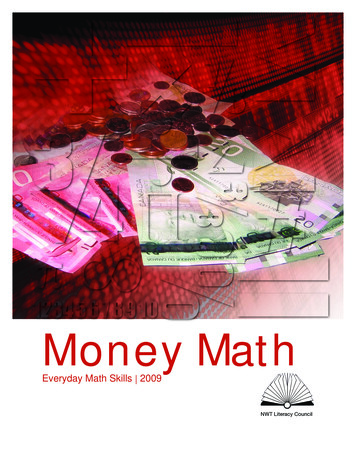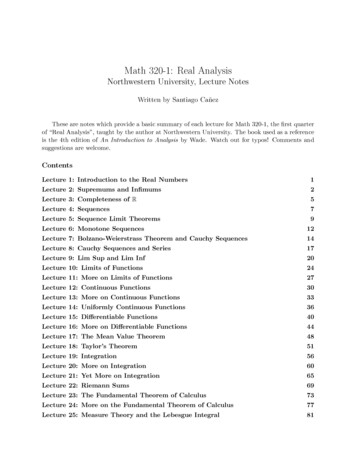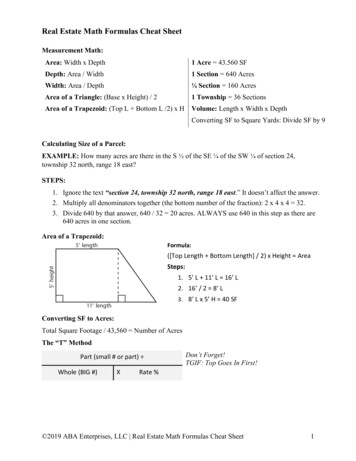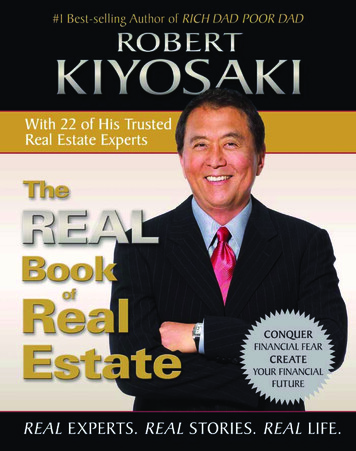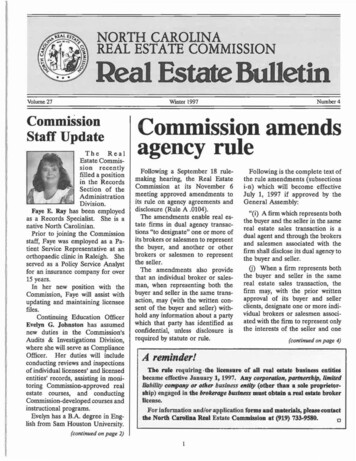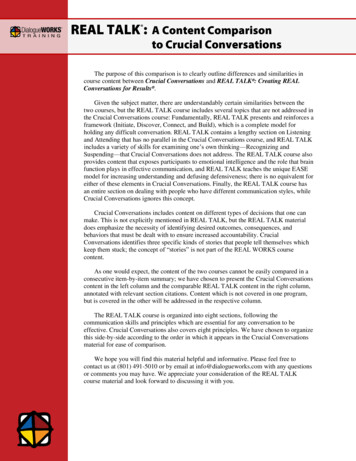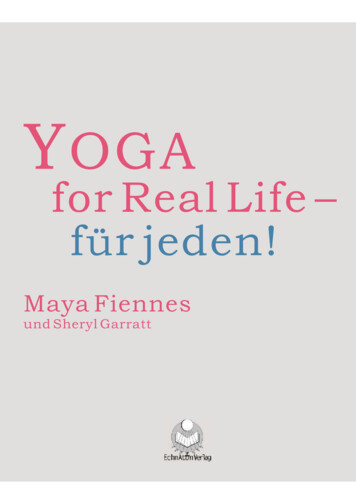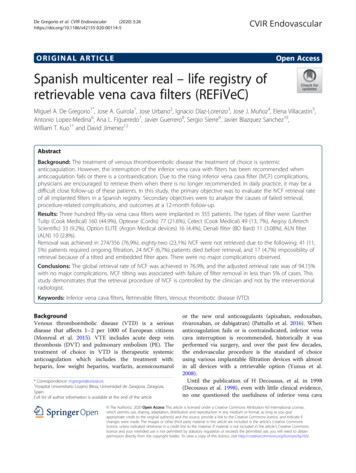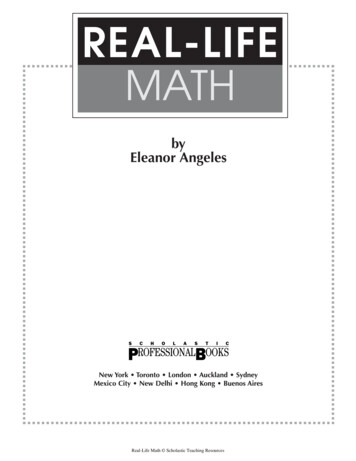
Transcription
REAL-LIFEMATHbyEleanor AngelesReal-Life Math Scholastic Teaching Resources
Photo credits:Illustration credits:Cover design by SolásInterior design by SolásScholastic grants teachers permission to photocopy the reproducible pages for classroom use.No other part of this publication may be reproduced in whole or in part, or stored in a retrievalsystem, or transmitted in any form or by any means, electronic, mechanical, photocopying,recording, or otherwise, without written permission of the publisher.For information regarding permission, write toPermission Dept., Scholastic Inc., 557 Broadway, New York, NY 10012ISBN: 0-439-23777-7Copyright 2002Real-Life Math Scholastic Teaching Resources
REAL-LIFEMATHCONTENTSIntroduction . . . . . . . . . . . . . . . . . . . . . . . . . . 5Before You Begin . . . . . . . . . . . . . . . . . . . . 6Section 1: Just the Facts . . . . . . . . . . . . . . . . 71. Addition . . . . . . . . . . . . . . . . . . . . . . . . . 82. Subtraction. . . . . . . . . . . . . . . . . . . . . . 113. Multiplication . . . . . . . . . . . . . . . . . . . . 134. Division . . . . . . . . . . . . . . . . . . . . . . . . 165. Estimating . . . . . . . . . . . . . . . . . . . . . . 196. How to Use a Pocket Calculator . . . . . . 217. Skills Survey. . . . . . . . . . . . . . . . . . . . . 23Section 2: Your Daily Math . . . . . . . . .1. Money Tracker . . . . . . . . . . . . . . .2. (Unit Price x Quantity) Sales Tax3. Paying for a Meal . . . . . . . . . . . . .4. How to Save on Transportation. . .5. At the Grocery . . . . . . . . . . . . . . .6. In the Post Office . . . . . . . . . . . . .7. Putting It All Together . . . . . . . . . .8. Skills Survey. . . . . . . . . . . . . . . . .242526272930313233Section 3: Your Money and Math.1. Checking Account . . . . . . . .2. Balancing Your Checkbook. .3. Savings . . . . . . . . . . . . . . . .4. Budgeting. . . . . . . . . . . . . . .5. Renting an Apartment. . . . . .6. Are You Covered?. . . . . . . . .7. All About Credit . . . . . . . . . .8. Filing Your Income Tax . . . . .9. Putting It All Together . . . . . .10. Skills Survey. . . . . . . . . . . . .3435373941434546485052.Section 4: Math Goes to Work.1. The Best Paying Job . . . .2. Working Time . . . . . . . . . .3. Time-and-a-Half . . . . . . . .4. Earning by the Piece or by5. What Is Profit? Loss? . . . .6. Pricing . . . . . . . . . . . . . . .7. Bookkeeping . . . . . . . . . .8. Putting It All Together . . . .9. Skills Survey. . . . . . . . . . . . . . . . . . . . 53. . . . . . . . . . 54. . . . . . . . . . 55. . . . . . . . . . 56Commission 58. . . . . . . . . . 59. . . . . . . . . . 61. . . . . . . . . . 62. . . . . . . . . . 63. . . . . . . . . . 65Section 5: Math Savers . . . . . . . . . .1. City and Highway Mileage . . . .2. Gas Saving Habits . . . . . . . . . .3. Do It Yourself . . . . . . . . . . . . . .4. Using the Calculator’s Memory .5. Discounts . . . . . . . . . . . . . . . . .6. Buy More, Pay Less . . . . . . . . .7. Putting It All Together . . . . . . . .8. Skills Survey. . . . . . . . . . . . . . . . . 66. . . 67. . . 69. . . 70. . . 71. . . 73. . . 74. . . 75. . . 76Section 6: Math Where You Least Expect It1. Where Does Your Team Stand? . . . . . .2. Going Places . . . . . . . . . . . . . . . . . . . .3. Temperature Change . . . . . . . . . . . . . .4. The Metric System . . . . . . . . . . . . . . . .5. Shopping With Foreign Money . . . . . . .6. Putting It All Together . . . . . . . . . . . . . .7. Skills Survey. . . . . . . . . . . . . . . . . . . . .7778798183858788Glossary . . . . . . . . . . . . . . . . . . . . . . . . . . . 89Answer Key . . . . . . . . . . . . . . . . . . . . . . . 91Real-Life Math Scholastic Teaching Resources
Real-Life Math Scholastic Teaching Resources4
IntroductionWHO NEEDS SCHOLASTIC REAL-LIFE MATH?You do.Because no matter what you do in life,math is there.Scholastic Real-Life Math gives you practice using math foreveryday situations.To get and keep a job, you need math skills.To run a home or a workshop, you need math skills.In sports, travel, shopping—you use math every day.So, whether you need math at the grocery store or on a vacation, each sectionwill improve your necessary math skills.Most lessons have aQuick Reference Box. This is the information you willneed to do the exercises.If you need help with any of the calculations, just turn to page 89. Here, in theGlossary, you will find the meanings of any unfamiliar words. Remember tokeep a pad of paper by you at all times: You will need it for calculations!TheSkills Survey pages at the end of each section can be used to test yourprogress.Real-Life Math Scholastic Teaching Resources5
Before You BeginHere is some basic information you will need to know before going any further.Place Valuesthe chart is different. Each place has ten timesthe value of the next place to the right. A 5 in thehundreds place has a value of 5 x 100, or 500. A1 ,5 in the hundredths place has a value of 5 x 100or5 .1005 is .05.Another way to represent 100TenthsHundredthsThousandthsThe value of 5 in each of the places shown onBillionsHundred MillionsTen MillionsMillionsHundred ThousandsTen ThousandsThousandsHundredsTensOnesPLACE VALUES5, 5 5 5, 5 5 5, 5 5 5 .5 5 5Answer the following questions.1. What is the value of 2 in the hundreds place?2. What is the value of 2 in the hundredths place?place.4. An 8 in the thousands place has a value ofplace.Write the following numerals in the Place Values Chartat right. The first one is done for you.BillionsHundred MillionsTen MillionsMillionsHundred ThousandsTen ThousandsThousandsHundredsTensOnes5. .008 means that the 8 is in thePLACE VALUES.Thirteen million, one hundred thirty-four thousand,nine hundred twenty1 3, 13 4, 9 2 0 .TenthsHundredthsThousandths3. 3/10 is another way to represent 3 in the0 0 0Seventy eight and two tenthsSix hundred fifty-five thousand,two hundred seventeenTwo hundred thirty-fourOne billion, five hundred six million,and one hundred twenty-five thousandEight thousand two hundred twenty-oneand five hundredthsReal-Life Math Scholastic Teaching Resources6
Just the Facts1You are a mathematician.sectionbuying groceries, counting change,or scoring a ballgame, you are using mathskills.When you’reThe exercises in Section 1 will help you prepare for thereal-life problems you will face later on in this book.Contents1. Addition . . . . . . . . . . . . . . . . . . . . . . . . . 82. Subtraction . . . . . . . . . . . . . . . . . . . . . 113. Multiplication . . . . . . . . . . . . . . . . . . . . 134. Division . . . . . . . . . . . . . . . . . . . . . . . . 165. Estimating . . . . . . . . . . . . . . . . . . . . . . 196. How to Use a Pocket Calculator . . . . . 21Skills Survey . . . . . . . . . . . . . . . . . . . . 23Real-Life Math Scholastic Teaching Resources7
1. ADDITIONAddition and Subtraction TableUse this table to add and subtract. To add two numerals, find one in bold in the toprow, and the other in bold in the left-hand column. To find your answer, follow theircorresponding row and column until they meet. To subtract, work backward usingthe same 121314151617181920Use the directions above to find the answers to the following problems. Write the letterof the problem next to each answer in the table.A. 13 – 6B. 8 7We use addition to find out theC. 14 – 9total when we combine two or more numbers.Real-Life Math Scholastic Teaching Resources8
Use what you’ve learned.Complete the table below.0 000 110 221 011 121 232 023 143 254 044 155 055 166 068 0831 781 891 9102 9112 792 8103 473 583 693 7103 8113 9124 374 484 6105 7125 8136 8146 5116 6126 7137 5127 6137 7148 4128 5138 6149 4139 5147 3109 3124 8125 5106 4109 716Next, add the tens.301b. 1254522435 9147 9168 8168 9179 8179 918b. 617321b. 223132c. 617321c. 2231325.6.5300405Then add the hundreds.301c. 1254522437First add the ones:3014521 672 683453450 992 57Addition: Working Right to LeftWhen you add numbers with many digits,begin with the column on the right, the ones.HundredsTensOnes0 882 465 387 290 772 358 2109 1100 551 346 287 189 094 260 441.2.3.a. 125243a. 617321a. 223132Write the sums.7534.Real-Life Math Scholastic Teaching Resources9
AdditionAddition: Working With More Than Two NumbersExample: Find the sum of 5 3 9. First add 5 3 to get 8.Then add 9 to 8 to get 17. (Hint: When adding with more thantwo “addends,” or numbers, you can group them first and addas you go along to make things easier.)1. 2 1 5 2. 3 4 6 3. 4 5 2 1 4. 1 3 7 9 5. 6 5 8 7 Addition: RegroupingExample: Add 68 26. First, line up the two numbers to addthem. Next, add the ones: 8 6 14. Write 4 beneath the onescolumn. You still have 1 ten from 14. Then add that 1 ten from14 to the tens column. Add the tens: 1 6 2 9.Write 9 beneath the tens column. Your answer is 94.16868 2694 264Find the sums.1.74 162.57 383.26 554.49 485.6.85 757.49 688.39 8478 369.175 2810.29 38411.354 29612.158 49313.126 5914.782 15615.365 80916.485 76017.924 7618.864 24719.346 87620.984 24921. 1787 90722. 2528 64523. 2637 736324. 1743 9878Lining Up Numbers to AddLine up numbers by place value. Ones must line upwith ones, tens must line up with tens, and so on.To add 23 1 3251 401, line them up this way:2313251401Line up these addends and find the sums.1. 235 4 61 4000 2. 4312 34 5 789 Adding Long ColumnsYou can add long columns of numbers in different ways. Hereare some suggestions to solve the following problems.Add the ones 5 8 4 2 19Add the tens 50 50 30 10 140Add the hundreds 400 600 800 200 2000Then, add the ones, tens, and hundreds together.45519658140834 2000 2122159Or, try this method.1. Add the first two numbers: 455 658 11132. Add the next two numbers: 834 212 1046Then, add your two answers together to find the final sum (2159).Find the sums using the method that’s easiest for you.1. 1242. 8753. 2674. 786953235725935687492128547 618 953109 456 63Checking SumsOne way to check your answer in addition is to change the orderof the “addends,” or numbers you’re adding. You should alwaysget the same sum. Practice this by checking your answers forquestions 1– 4, e Math Scholastic Teaching Resources203710
2. SubtractionSubtraction of Whole NumbersWe use subtraction to find thedifference between two numbers.Complete the table ��9515–9616–9717–8917–98The Relationship Between Addition and SubtractionAdditionSubtraction2?5 3 3–3552 — differenceReal-Life Math Scholastic Teaching Resources11
SubtractionFind the DifferneceRewrite each addition problem below as asubtraction problem. Then find the difference.In each example below, the larger number can berenamed before the smaller number is subtracted.Find the differences.2 141. ? 9184.352.22 ?3.39285.? 7?6. 701 ? 213 ?347635705Example: Subtract 45 – 18.First, rewrite 45 as 3 tens and 15 ones.Place the 15 ones in the ones column and the3 in the tens column.3 1545–18Write 7 beneath the ones column.Finally, subtract the tens.3 1545–18271. 22–32. 35–83. 26–76. 431– 637. 352– 748. 234– 554. 47–95. 58–94 11 15525– 864399. 655– 6610. 286– 987 1413Renaming and RegroupingThen subtract the ones.15 – 8 7.34–628853 11. 222 12. 425 13. 512 14. 356 15. 685– 787– 169– 358– 424– 267– 598663 99 104000– 287371316. 300 17. 5200 18. 2005 19. 1050 20. 3020– 23– 199– 576– 561– 342Checking the DifferenceOne way of checking your answer to a subtractionproblem is to add the difference and the smallernumber. The sum should be equal to the largernumber. Practice this by checking your answersto 1–20 above.12601073– 187 18710731260Real-Life Math Scholastic Teaching Resources12
3. MultiplicationTo find the cost of 5 shirts at 6 each, you can add 6 6 6 6 6. A quicker way is to multiply.Multiplication and Division 0405060708090100Use this table to multiply and divide. To multiply two numerals, find one in bold in the top row, andthe other in bold in the left-hand column. To find your answer, follow their corresponding row andcolumn until they meet. To divide, work backward using the same method. The answers to thefollowing problems can be found in the table. Write the letter of the problem next to each answer inthe table above.A. 36 9B. 7 x 9C. 42 6Multiplication of Whole NumbersComplete the table 486x954Real-Life Math Scholastic Teaching 9729x5459x6549x7639x8729x98113
MultiplicationMultiplication: Working From Right to LeftUsing Two Partial ProductsExample: Multiply 123 x 2.First, multiply 3 x 2 to get 6. Write 6.Then multiply 2 x 2 to get 4. Write 4to the left of 6.Finally, multiply 1 x 2 to get 2.Write 2 to the left of 4.Your final answer is called a “product.”To find 27 x 56, you can use the following method.123x2246Find the 802x48. 931x327x 56162 (27 x 6) partial product 1350 (27 x 50) partial product1512 (162 1350) PRODUCT*Note: You do not have to write the 0 in 1350,because you will get the same product whether youwrite it or not.Find the products.1.42x 232.46x 313.81x 194.132x 245.345x 636. 1213x 32Using Your Memory in MultiplicationUsing Three Partial ProductsExample: Multiply 87 x 4.First, multiply 7 x 4 to get 28.87x48Write 8.Remember the 2 to get from 28. Thenmultiply 8 x 4 to get 32. Add the 2 fromthe previous step. 32 2 34.For the final answer, write 34 to theleft of 8.87x4348To find the product of 692 x 231, you can use thefollowing method.692x 231692 (692 x 1) partial product20760 (692 x 30) partial product 138400 (692 x 200) partial product159852 PRODUCTFind the products.Find the products.1. 952. 87x6x53. 64x84. 1375. 2096. 514x2x4x71. 765x 2112.Real-Life Math Scholastic Teaching Resources348x 1233.879x 3124.647x 25114
MultiplicationZeros in MultiplicationFind the products.Your solution to 225 x 304 may be found in differentways. Here are some suggestions.1. 58x10 First method:2. 58x100 3. 58x1000 4. 60x100 5. 45x10 6. 99x1000 100225x 304900000 (include the partial 675 product of zero)684007. 125 xSecond method:225x 304900675 (leave out the zero)68400Use either method to find the products.1. 352x 2052.864x 3023.506x 201Checking Your AnswersOne way of checking your answer to a multiplicationproblem is to interchange the two numbers to bemultiplied. Practice this by checking your answerson this page.4. 708x 403Multiplying by 10, 100, 1000To multiply a number by 10, 100, or 1000, here’swhat you do.35 x 10 350 Check:4315x 15x 43215415430600645PRODUCT645(35 x 1, add 1 zero)35 x 100 3500(35 x 1, add 2 zeros)35 x 1000 35000(35 x 1, add 3 zeros)Real-Life Math Scholastic Teaching Resources15
4. DivisionDivision of Whole NumbersHow can you find the price of 1 book if 5 books cost 20? You candivide.Complete the table below.01) 0121) 11) 202) 0122) 22) 403) 013) 331) 351) 571) 742) 852) 1062) 1233) 943) 1253) 1563) 1873) 2124) 834)1244) 1654) 2064) 2474) 28125) 55) 1035) 1545) 2065) 3075) 3526) 1236) 1846) 2456) 3037) 2147) 2857 ) 3504) 006) 007) 017) 708) 0128) 18) 1609) 0129) 99) 1848) 3239) 2759) 4566) 3681) 891) 982) 1692) 1893) 2784) 3295) 4586) 4896) 5477) 4987) 5697) 6368) 4878) 5688) 6498) 7269) 5479) 6389) 72quotient (the answer)11) 1dividend (the number you are dividing)divisor (the number you are dividing by)Real-Life Math Scholastic Teaching Resources16
DivisionHere is an easy, step-by-step guide to findinga quotient.Divide:Solving Division Problems276 23 is usually solved this way.96 ) 4608(1 x 23)To begin, 96 does not go into 4 or 46. So, how many96’s are in 460? Estimate by finding how many9’s are in 46. 46 9 is about 5, so try 5.5)96 4608Find the quotients.1. 9) 8282. 18) 234Zeros in the Quotient–480But 96 x 5 is 480. You can’t subtract because theanswer is still too big. Now try 4. 96 x 4 is 384,which can be subtracted from 460. Bring down the 8from the dividend. Now, how many 96’s are in 768?Estimate by finding how many 9’s are in 76.76 9 is about 8, so try 8.48)96 4608384768(2 x 23)12)23 276– 2346– 4600Try 4.384 can be subtracted from 460.Bring down the 8.Now, how many 96’s are in 768?The answer to 2461 23 might be incorrectly writtenas 17. It should be 107. To avoid this error, you maywrite your work like this.10723) 2461– 2316– 00161–161000quotientRemember: Each time you bring down one digit from thedividend, you must write one digit in the quotient.You may also avoid mistakes by estimating or“guessing” the quotient to check your work.For example:Remember: You can check if your answer is reasonable byEstimate 2461 23.estimating. 96 is about 100 and 48 is about 50. 100 x 50 5000. 4608 is about 5000, so the answer is reasonable.Round 2461 to 2000 and 23 to 20.Since 2000 20 100, you know that thequotient is about 100. So 17 is wrong.Find the quotients.1. 32) 65922. 19) 57953. 24) 96964. 17) 8534Real-Life Math Scholastic Teaching Resources17
DivisionShort Method of Dividing Rounded NumbersUsing Remainders in DivisionTo multiply 200 x 20, you simply write three zerosand multiply 2 x 2. Your answer is 4000.Here’s a practical example of how remainders indivision affect your everyday life: telling time.To divide 4000 200, this is what you do:4000 200 40 2 20To change minutes to hours, you divide the numberof minutes by 60. (60 min. 1 hr.) Sometimes thereare leftover minutes. In division, these leftovers arecalled remainders. Take a look at the followingexample.To divide 8000 4000:8000 4000 8 4 2135 min. 60 min. ?Based on these examples, here is a simple rulefor dividing rounded numbers: Cross off the samenumber of zeros from the divisor and dividend anddivide the numbers you are left with.Find the quotients.The answer is 2 hours and 15 minutes.260) 13512015 (remainder)1. 6000 2000 You will not only find this useful with time, but withother measurements as well.2. 4500 900 3. 3500 700 4. 800 200 Find the quotients and the remainders.What will be the first digit in each quotient?1. a. 40) 1728b. 48) 17282. a. 70) 3672b. 72) 36723. a. 20) 1152b. 24) 11521. 198 min. 60 min. .hours .minutes2. 56 inches 12 inches .feet .inches3. 86 days 24 hours .days .hours4. 556 ounces 16 ounces .pounds .ouncesReal-Life Math Scholastic Teaching Resources18
5. Estimating“Guessing” the AnswerHow often do you ask yourself, “Do I have enough money?” You can find a quick,reasonable answer byestimating, or “guessing” to find a close answer to amath problem.Quick ReferenceDave’sDiscountStoreThe question to be answered often tells you how toestimate. For example, here are two different questionsabout the same advertisement. The estimates are done inSALE!different ways. What is the cost of 2 batteries at 78 each?Step 1: Round 78 to 80 BatteriesStep 2: 80 80 or 80 x 2 is 160.78 eachSo, the cost of 2 batteries is about 1.60OR(AAA, AA, C & D in stock now)Is 1.60 enough to buy 2 batteries?Step 1: Figure 1.60 2 80 Step 2: Since 78 is about 80 , the answer isprobably yes.You may have your own ways of estimating. Here’s a chance for you to use them.Look at the facts in the ad for cassettes below. Quickly guess the answer to eachquestion and circle it. Do not use pencil and paper to find the answer.1.How much does each cassette cost?About 12.About 2Can you buy 2 cassettes for 4?Yes3.NoHow many cassettes can 12 buy?6Real-Life Math Scholastic Teaching Resources7819
Use what you’ve learned.Guessing the answer to a problem is one way to check if your actual answer is right or wrong. Forexample, if your estimated answer is 1000 and your actual answer is 110, you know that you made amistake somewhere. You should do the problem again.There are many ways to estimate. As you’ve seen in previous sections, one common method used toestimate answers in math problems is to round numbers to the nearest ten, hundred, or thousand sothat you can work with them more easily.For example: Estimate 898 204Sum898 2041102is rounded tois rounded toEstimate the products.900 2001100Estimate1. 29 x 31:x 2. 88 x 52:x 3. 394 x 203x Estimate the sums.1. 813 692: 2. 3185 1812: 3. 62 78 39: Estimate the quotients.1. 4105 79: 2. 2950 51: Estimate the differences.1. 706 – 598:– 2. 497 – 208:– 3. 6028 – 3982: – Real-Life Math Scholastic Teaching Resources20
6. How to Use a Pocket CalculatorApocket calculator can save you a lot of time in solving math problems.Of course, you must tell it what you want it to do. This lesson will help you get moreout of your calculator.Some calculators have different features. The one shown here is a commontype of calculator with a memory. The keys must be pressed in the correctorder to get the right answer.Here is an example that shows you how to use your calculator.To add 12 35:A. Press AC (or C) to clear the machine.B. Press 1 and then 2 for 12. The read-out will show 12.C. You want to add, so press .D. Press 3 and then 5 for 35. The read-out will show 35.E. Press to get the answer. The read-out will show 47.Now do this: 27 45 – 39Press the keys in this order:AC 27 4 5 – 39 The read-out will show 33.Real-Life Math Scholastic Teaching Resources21
Use what you’ve learned.1. To find the answer to 35 8, which is the correctorder for pressing the keys?4. Choose the correct operation ( , –, x, or )and write it in the space provided.a. AC 35 8 b. AC 358 a. 3 5 8b. 13 6 7c. 35 AC 8 d. 35 AC 8c. 4 5 20d. 18 3 62. To find the answer to 17 23 – 8, which is thecorrect order?a. 17 AC 238 – c. 1 723 – AC 85. Fill in the keys you must press to find theanswer to each problem. The first one isdone for you.b. AC 17 23 – 8 d. AC 1723 – 8 3. To find the answer to 7 x 8 4, which is thecorrect order?a. AC 78 x 4 b. 784 x AC c. 7 x AC 8 4d. AC 7 x 8 4 a. 31 23AC 31 23 b. 17 – 11c. 49 7d. 36 x 12e. 3 7 9 – 8f. 17 – 6 11 – 2To build on these calculator skills,please turn to page 71, Using theCalculator’s Memory.Real-Life Math Scholastic Teaching Resources22
Skills SurveyYou have learned some essential math skills to help with your daily activities.The exercises in this section will help sharpen your skills.Solve the math problems below without using acalculator.1.56 412.352 263.263 7154. 2136 40415.356.487.5078. 726 197 384 6 25Subtract without using a calculator.11. 48–1712. 352–8513. 6000–13414. 3060–483Multiply without using a calculator.Line up the addends and find the sums withoutusing a calculator.9.15. 32x316. 602x217.75x418. 412x719. 24x3220. 253x2621. 531x21322. 304x50242 200 2312 3 Divide without using a calculator.10.4 7201 33 120 23. 32) 38424. 8)77625. 26)790426. 4500 90 Real-Life Math Scholastic Teaching Resources23
Your Daily Math2sectionWhere has all the money gone? How much do I have tosave to buy that car? How can I earn more?Which item is the better buy? What’s the score?You can nowuse your math skills toanswer these questions, and more.Contents1. Money Tracker . . . . . . . . . . . . . . . . . . . 252. (Unit Price x Quantity) Sales Tax . . . . 263. Paying for a Meal . . . . . . . . . . . . . . . . . 274. How to Save on Transportation . . . . . . 295. At the Grocery . . . . . . . . . . . . . . . . . . . 306. In the Post Office . . . . . . . . . . . . . . . . . 317. Putting It All Together. . . . . . . . . . . . . . 32Skills Survey . . . . . . . . . . . . . . . . . . . . 33Real-Life Math Scholastic Teaching Resources24
1. Money TrackerThis lesson answers the question,“Where has all the money gone?”and will help you keep track of your expenses.Complete this week’s calendar of expenses.Quick ReferenceSubtract the expense, or amount paid, fromBalance is the cash or money on hand.lines provided. Make sure to carry overWhen subtracting money, be sure that the decimal points areeach End-of-Day balance to the start of theeach balance. Write your answers on thenext day.lined up.The difference, or new balance, is the answer to a subtractionproblem.Keep track of your Saturday expenses.Write the amount of money you have on thefirst line. Subtract each expense. Howmuch do you have at the end of the day?To check each answer, add the difference and the amountsubtracted. The sum should be the same as the originalamount. For example: 150.00 148.50–1.50 1.50 148.50 150.00 350.00Start-of-Day BalanceExpenseBus FareNew BalanceExpenseLaundryNew BalanceFridaySaturday16.99Groceries 11.83Newspapers1.203.39 Film4.83 Jeans32.98Legal Pad1.67Birthday Gift 9.873.60CDs11.74 Lunch5.68 nt4.99Paperback 3.08Vase6.25339.90Newspaper.75RunningBand Aids 4.08 Light Bulbs 2.70 Shoes339.15Ball Game 2.50New BalanceExpenseThursday343.50New BalanceExpenseWednesday 328.78Train Ticket 10.00 PhotoDeveloping 7.02 SweaterContribution 5.00 BreakfastNew BalanceExpense1.50Tuesday348.50New BalanceExpenseMondayPictureWatch Repair15.63 Frame3.79 SnackMagazineExercise4.32 Class332.65Snack1.872.25 Socks2.2710.00ConcertTickets37.00Cab Fare6.35328.78ExpenseDry Cleaners 8.10New BalanceExpenseEnd-of-Day BalanceDinner328.78Real-Life Math Scholastic Teaching Resources12.90EXPENSE CALENDARSunday25
2. (Unit Price x Quantity) Sales Tax6% Sales Tax ChartAmount of SaleTax .00 – .10 none.11 – .17 .01.18 – .34 .02.35 – .50 .03.51 – .67 .04.68 – .84 .05.85 – 1.10 .061.11 – 1.17 .071.18 – 1.34 .081.35 – 1.50 .091.51 – 1.67 .101.68 – 1.84 .111.85 – 2.10 .122.11 – 2.17 .132.18 – 2.34 .142.35 – 2.50 .15Have you ever been surprised thatthe bill for a 10.00 item is 10.60?This lesson will help you understandsales tax and how it affects theamount a customer pays.On eachsales receipt, find thetotal cost of the items described bymultiplying the unit by the pricequantity. Then add the amounts inthe total-cost column to find thesubtotal. Use the sales tax chart toAmount of Sale2.51 – 2.672.68 – 2.842.85 – 3.103.11 – 3.173.18 – 3.343.35 – 3.503.51 – 3.673.68 – 3.843.85 – 4.104.11 – 4.174.18 – 4.344.35 – 4.504.51 – 4.674.68 – 4.844.85 – 5.105.11 – 30.31Amount of Sale5.18 – 5.345.35 – 5.505.51 – 5.675.68 – 5.845.85 – 6.106.11 – 6.176.18 – 6.346.35 – 6.506.51 – 6.676.68 – 6.846.85 – 7.107.11 – 7.177.18 – 7.347.35 – 7.507.51 – 46Amount of Sale7.68 – 7.847.85 – 8.108.11 – 8.178.18 – 8.348.35 – 8.508.51 – 8.678.68 – 8.848.85 – 9.109.11 – 9.179.18 – 9.349.35 – 9.509.51 – 9.679.68 – 9.849.85 .60determine the tax on the subtotal. Add the subtotal and the tax to find the final amount due from the customer. Wedid the first one for you.sum of the amounts in total-cost columnQuantity or qty. is the number of items purchasedor bought.StationeryItem Description Unit PricePens.79Qty.3Total Cost 2.37Memo Pad.3951.95Scotch Tape.411.41Pencils.154.60Subtotal6% Sales TaxPay this amountUnit price is the cost of one item.Total cost is Unit Price x Quantity.The answer in multiplication is called the product.tax for 5.33as shownon salestax chart 5.33.32 5.65sum of subtotal and sales taxItem DescriptionUnit Price Qty.5.792Color Prints.3612Batteries2.3265x7 Enlargements3.155Subtotal6% Sales TaxPay this amountSubtotal is the sum of the amounts in the total-costcolumn before the sales tax is added.6% Sales tax means an addition of .06 on eachdollar of purchase. (Many states and cities raisemoney through sales taxes. The customer pays thetax in the store.) To use the Sales Tax Chart, find thesubtotal ( 5.33) within the two amounts ( 5.18– 5.34)shown in the amount-of-sale columns. The salestax (.32) is at the right of this column.Total CostAlan’sCamera SupplyFilmQuick ReferenceOn Your OwnMake a receipt of some things you boughtrecently. What did you buy? How many? Howmuch did each one cost? How much taxwas included in the total amount you paid?Remember: The tax in your state may bedifferent.Real-Life Math Scholastic Teaching Resources26
3. Paying for a MealEating OutEstimate how much money youthink you’ll need. Then, when you order, add up the prices of the items youwish to order to make sure you have enough money. When yourWhen you go out to dinner, first plan ahead.bill comes, be sure to check your waitperson’s math! Don’t forgettax and tipEntréeHamburger . . . . . . . . . . . . . . 5.00Cheeseburger. . . . . . . . . . . . . . 5.85Chopped St
Scholastic Real-Life Mathgives you practice using math for everyday situations. To get and keep a job, you need math skills. To run a home or a workshop, you need math skills. In sports, travel, shopping—you use math every day. So, whether you need math at the grocery store or on a vacation, each section

